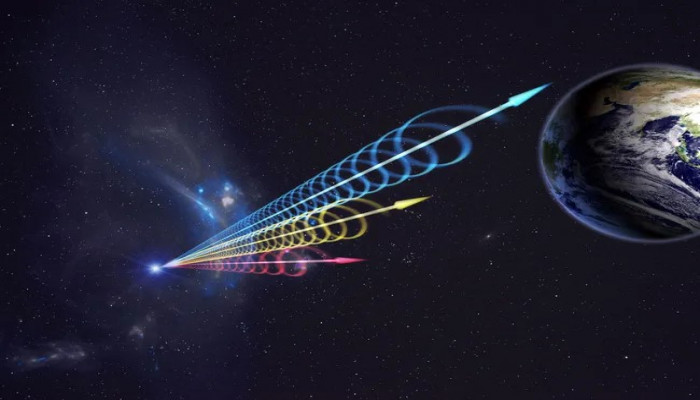Radio signal reaches earth after 8 billion years of space travel
- In Reports
- 03:13 PM, Oct 20, 2023
- Myind Staff
Astronomers have recently observed a distant and highly energetic burst of radio waves that has traversed space for 8 billion years to reach Earth. This remarkable event is known as a fast radio burst (FRB), a category of intense, millisecond-long radio wave bursts that continue to baffle scientists with their enigmatic origins. The first FRB was initially identified in 2007, and since then, astronomers have detected hundreds of these fleeting cosmic phenomena emanating from various remote corners of the universe.
This specific FRB, designated as FRB 20220610A, was a remarkably brief event, lasting less than a millisecond. However, within that minuscule timeframe, it emitted energy equivalent to what our sun typically radiates over a span of 30 years. These findings were detailed in a study published in the journal Science.
Fast radio bursts pose a considerable challenge to researchers due to their incredibly brief and intense nature, often vanishing within milliseconds of appearing. This characteristic makes them particularly elusive for observation.
To uncover the source and characteristics of FRBs, astronomers have harnessed the capabilities of radio telescopes. Notably, the ASKAP array of radio telescopes, situated in the Wajarri Yamaji Country of Western Australia, played a pivotal role in this discovery. Astronomers utilized ASKAP to detect and pinpoint the FRB in June 2022, shedding light on its origin and advancing our understanding of these intriguing celestial events.
“Using ASKAP’s array of (radio) dishes, we were able to determine precisely where the burst came from,” said study co-author Dr. Stuart Ryder, an astronomer at Macquarie University in Australia, in a statement. “Then we used (the European Southern Observatory’s Very Large Telescope) in Chile to search for the source galaxy, finding it to be older and (farther) away than any other FRB source found to date and likely within a small group of merging galaxies.”
The research team linked the burst to merging galaxies, supporting the theory of fast radio bursts originating from magnetars. These bursts could offer a novel method to measure unaccounted-for intergalactic matter, allowing scientists to "weigh" the universe.
If we count up the amount of normal matter in the Universe — the atoms that we are all made of — we find that more than half of what should be there today is missing,” said study coauthor Ryan Shannon, a professor at Swinburne University of Technology in Australia, in a statement. “We think that the missing matter is hiding in the space between galaxies, but it may just be so hot and diffuse that it’s impossible to see using normal techniques.”
Current methods for estimating the universe's mass yield conflicting results, indicating that there may be unaccounted-for components beyond the known scope of the universe. “Fast radio bursts sense this ionized material,” Shannon said. “Even in space that is nearly perfectly empty they can ‘see’ all the electrons and that allows us to measure how much stuff is between the galaxies.”
In 2020, the late Australian astronomer Jean-Pierre Macquart demonstrated the use of fast radio bursts to detect previously unaccounted-for matter. “J-P showed that the (farther) away a fast radio burst is, the more diffuse gas it reveals between the galaxies. This is now known as the Macquart relation,” Ryder said. “Some recent fast radio bursts appeared to break this relationship. Our measurements confirm the Macquart relation holds out to beyond half the known Universe.”
Researchers have tracked the origins of nearly 50 fast radio bursts, with ASKAP being instrumental in detecting approximately half of them. “While we still don’t know what causes these massive bursts of energy, the paper confirms that fast radio bursts are common events in the cosmos and that we will be able to use them to detect matter between galaxies, and better understand the structure of the Universe,” Shannon said.
Astronomers express their hope that future radio telescopes, presently under construction in South Africa and Australia, will facilitate the detection of thousands more distant fast radio bursts. “The fact that FRBs are so common is also amazing,” Shannon said. “It shows how promising the field can be, because you’re not just going to do this for 30 bursts, you can do this for 30,000 bursts, make a new map of the structure of the universe, and use it to answer big questions about cosmology.”
Image source: BBC News







Comments